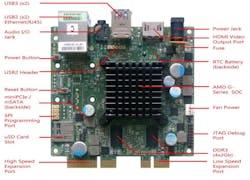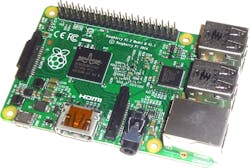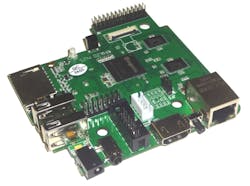Checking Out the Gizmo 2, Raspberry Pi 2, and the Creator CI 20
New boards keep piling up in the lab. I have been playing with them, but have not taken the time to write about them like I should. It is too much fun exploring—but here is a quick overview of some of the latest (see “What Can You Make with These Development Boards?”) that I have plugged in and how they fared.
Gizmo 2
The $199 Gizmo 2 (Fig. 1) is the latest from Gizmosphere. It pushes the performance envelope past the original Gizmo (see “Embedded GizmoSphere APU Delivers over 52 GFLOPS”). Both are based on AMD’s APU, but the Gizmo 2 uses the latest AMD Embedded GX0210HA and is available from a range of vendors. The 1 GHz APU includes a dual “Jaguar” x86 64-bit core plus a 300 MHz Radeon 9210E GPU. The APU (accelerated processing unit) architecture provides a unified memory space for the CPU and GPU (see “APU Blends Quad Core x86 with 384 Core GPU”). The APU has a 9W TDP, so the heatsink fan is optional depending upon conditions and the application.
The APU provides a power compute and display platform. The most limiting factor is the 1 Gbyte of DDR3-1600 SDRAM that is not expandable. It is more than sufficient to run TimeSys Linux as well as other operating systems with enough headroom of applications. It also keeps the cost and power requirements down.
One of the other systems I tested was Windows Embedded 8. It helps to have a Microsoft MSDN account to get access to the tools and operating system. It highlights how nice the system can be for hosting a stripped-down version of Windows without all the apps you find on a new PC or laptop. The system supports DirectX 11. OpenCL and OpenGL that utilize the GPU are supported on a number of operating systems, including Windows and Linux.
From an Internet of Things (IoT) perspective, the Gizmo 2 fares very well. It has a 1 Gbit Ethernet connection, and the miniPCIe/mSATA port underneath can handle storage as well as wireless options such as Wi-Fi or GPS. There is a microSD slot, and the unit I received came with a microSD flash card. If you need more storage, there is a high-speed card-edge interface with PCI Express support. Low-speed interfaces are also available. The system has high-performance interfaces like Gigabit Ethernet and USB 3.0. It also has a bunch of USB 2.0 ports on the back panel and more on headers.
The USB 3.0 ports can also be used for storage or other devices like cameras. I was considering trying the new Intel Realsense 3D camera that requires USB 3.0 and Windows 8, but I am not sure if the system meets the other requirements yet.
Start-up was simple with the microSD card or using a USB DVD drive to load up a new system. The audio support worked nicely with my speakers, and the HDMI works with most new monitors. Unfortunately, most of my monitors have older VGA connections, but I have a few HDTVs that work rather nicely with the Gizmo 2.
The system can easily handle native development, but the memory limitation will push most developers back to their PCs. I have one with 32 Gbytes, and more RAM makes a difference when using today's IDEs. On the other hand, non-volatile storage is not an issue. I have seen 128 Gbyte mSATA modules for less than $100. The hardware also does an impressive job driving HDMI displays.
The hardware is open-source so taking this platform to a custom board is a viable course. The CPU can be run without the fan, depending upon how hard you push it. The platform allows development of fanless solutions. Just be careful.
There is also a JTAG interface that I did not check out. This can be handy for hardware development, but is not necessary for application development when using most standard peripherals.
Raspberry Pi 2
The Raspberry Pi 2 (Fig. 2) disappeared from store shelves almost as soon as it was announced. There are likely to be sufficient supplies now, but the large community was waiting with bated breath for the quad-core Broadcom BCM2836. It is six times faster than the Raspberry Pi. The 900 MHz chip uses the same GPU as before and the board layout is the same as the earlier Raspberry Pi B Plus. This includes the placement of headers, the 10/100 Ethernet socket, and the four USB 2.0 ports. The price is still $35.
The board has 1 Gbyte of RAM and a microSD slot. Video is still via HDMI, but you can also use the two MIPI display interfaces or the composite video output. The MIPI interfaces can be used for camera input.
There are way too many OS options to choose from with the Raspberry Pi 2. One will eventually be Windows 10, but for now a number of Linux options tend to dominate.
So it is easiest to compare the Raspberry Pi 2 to the initial version and the B Plus. It is faster. Enough said. Getting the system running is just a matter of downloading Linux onto the flash drive and popping it into the system. The larger memory is really nice and so are the extra cores, making it practical to do some serious development on the board. I still do cross-development, though, because it is hard to compete with more memory and multiple screens.
Creator CI20
The Creator CI20 is priced at $65. It is based on Ingenic’s dual-core, 1.2 GHz JZ4780 SoC. The chip is built around Imagination’s MIPS32 architecture. It includes a PowerVR SGX 540 GPU that is similar to the one found on the iPhone 4. There is 1 Gbyte of DRAM on-board and 8 Gybtes of flash memory. Of the three, this was the big unknown, since I had looked at prior versions of the Raspberry Pi 2 and Gizmo 2. I have, however, played with a number of MIPS-based solutions, including Microchip’s PIC32 line.
The JZ4780 is designed for mobile applications, so power conservation is key. It is designed to handle communication interfaces like Bluetooth, GPS, and Wi-Fi. The board has 802.11 b/g/h Wi-Fi and Bluetooth 4.0 built in. This alone makes it stand out from the other two and makes the price more comparable, if not lower, when including add-ons.
The board is an odd size with the camera and I/O header off to one side. The rest is pretty conventional with the Ethernet, USB, HDMI (up to 2K), and SD card sockets around the periphery.
The OS selection is more limited with Android and Debian Linux being the current choices. It can handle other operating systems, but that will require a lot more effort. Sideloading was required to get more than the basics with Android. At this point it is easier to deal with Debian, although both are reasonable cross-compiler targets.
It all depends upon what you want to do with the Creator CI20, and there is the rub. If you are a newbie looking for a large ecosystem, then stick with the Raspberry Pi. If you are looking for developing an embedded wireless application where cost and power are key, then take a closer look at the CI20. Like the Raspberry Pi, it can be used for development, but remote access is really the way to go and having Wi-Fi support makes it easy to download to a remote device unless you need to avail yourself of the EJTAG interface.
Summary
Of the three, the Gizmo 2 is obviously the powerhouse of the group. It could be used as a desktop PC, although its 1 Gbytes of DRAM, small compared to today’s desktops, tend to be limiting. It can handle plenty of flash storage though, and the Mini-PCIe slot opens wireless possibilities.
The Raspberry Pi has such a massive ecosystem that the Raspberry Pi 2 will succeed simply by momentum. On the other hand, this is one nice board and addresses the performance issues brought up with the prior versions.
The Creator CI20 is a very nice platform that lacks the Raspberry Pi’s ecosystem. But the board has a low-power processor with wired and wireless support. The other two platforms only have wired support built in. Don’t discount the MIPS architecture either, as many reviewers have done. Too many tend to be focused on what they have used and know about and are often unaware that MIPS systems reside in a lot of embedded hardware. The platform supports Linux and Android, so there is no lack of software--although some may need to be recompiled.
Each has its place and I can recommend all three as useful and economical development platforms.
About the Author
William Wong Blog
Senior Content Director
Bill's latest articles are listed on this author page, William G. Wong.
Bill Wong covers Digital, Embedded, Systems and Software topics at Electronic Design. He writes a number of columns, including Lab Bench and alt.embedded, plus Bill's Workbench hands-on column. Bill is a Georgia Tech alumni with a B.S in Electrical Engineering and a master's degree in computer science for Rutgers, The State University of New Jersey.
He has written a dozen books and was the first Director of PC Labs at PC Magazine. He has worked in the computer and publication industry for almost 40 years and has been with Electronic Design since 2000. He helps run the Mercer Science and Engineering Fair in Mercer County, NJ.
- Check out more articles by Bill Wong on Electronic Design
- Bill Wong on Facebook
- @AltEmbedded on Twitter



